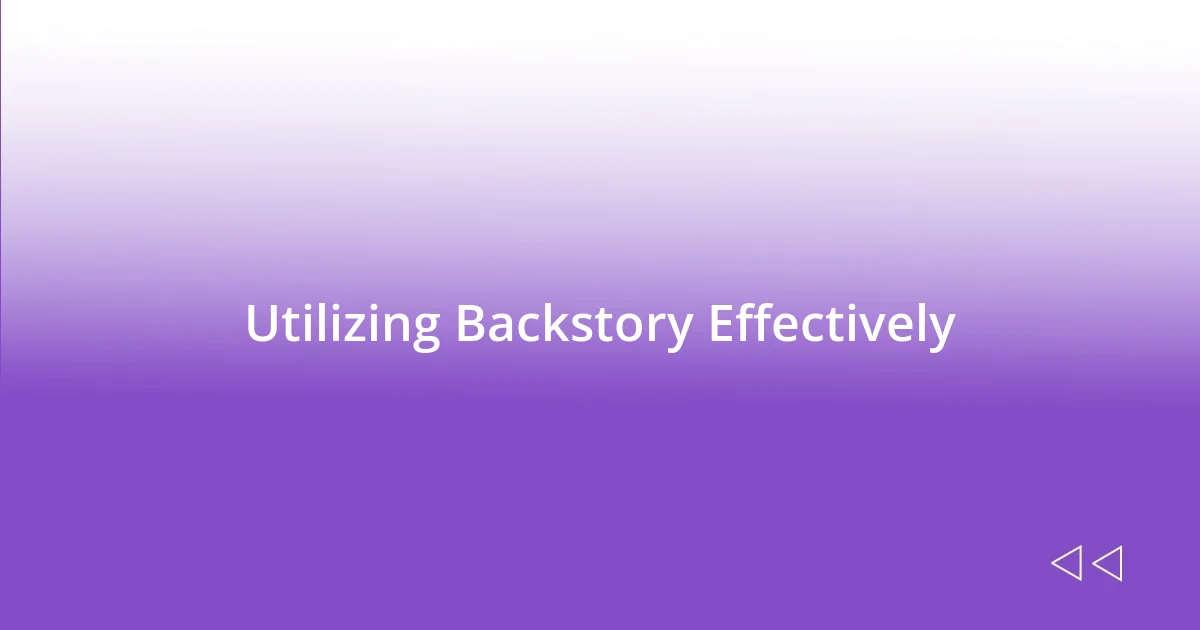Key takeaways:
- Character development is enhanced through understanding motivations, backstories, and emotional stakes, making characters relatable and deeply engaging.
- Character arcs are crucial for storytelling, as they create emotional connections and drive the plot forward by showcasing internal conflicts and growth.
- Feedback and revision play a vital role in refining character depth, ensuring that their actions and decisions align authentically with their established narratives.

Understanding Character Development
Character development is a multi-dimensional process, and I often think of it as a journey. Remember that moment when you realized a character had transformed in a profound way? It’s like watching someone you know deeply evolve in front of your eyes—this transformation can hit hard emotionally. I love to create complex backgrounds for my characters because it gives them a rich tapestry to draw from as they face new challenges.
In my experience, understanding a character’s motivations is key to developing them authentically. Have you ever found yourself rooting for a character who seems flawed but relatable? Those layers of vulnerability and strength help the audience connect, making their decisions feel real and engaging. I often pull from my own life experiences when writing; the struggles I’ve faced become the problems my characters need to confront—this not only adds depth but also resonates with readers on a personal level.
One of the most powerful ways to deepen character development is through conflict. I recall a time when I was writing a short story and put my character in a moral dilemma that forced her to choose between love and loyalty. That struggle added an intensity that not only shaped her identity but also kept me, as the writer, engaged in her story. What if your character has to let go of something precious? Such moments challenge them and allow for both growth and reflection—something I believe every engaging character should experience.

Importance of Character Arcs
Character arcs play a crucial role in storytelling, serving as the backbone that supports and shapes a character’s evolution. When I think of a character arc, I envision a path of transformation, often mirroring my own experiences. I once wrote a character who started out stubborn and prideful but, through a series of humbling events, learned the value of compassion. That process of growth not only made the character more relatable but also resonated with readers who have faced their own struggles.
One of the key aspects of character arcs is their ability to create emotional stakes. I vividly remember crafting a story where a character had to confront their past mistakes. Each decision they made along their journey felt weighty, and I found myself invested in their path toward redemption. It’s that transformation—seeing someone navigate their flaws—that creates an emotional connection with the audience. After all, how often do we see ourselves in a character’s journey? It’s these arcs that remind us of our shared humanity and the potential for change.
Moreover, character arcs can drive the narrative forward. When characters grapple with internal conflicts, their choices influence the plot in meaningful ways. In my own writing, I’ve encountered situations where a character’s growth impacts not only their fate but also the lives of others around them. It’s fascinating when a personal transformation leads to larger consequences within the story, reinforcing the interconnectedness of character development and plot progression. How often have you found that a character’s journey incites new challenges? This interplay is what makes character arcs not just important, but essential.
| Aspect | Importance |
|---|---|
| Emotional Depth | Enhances relatable connections with the audience. |
| Plot Advancement | Drives the narrative by influencing key events. |
| Character Complexity | Creates multi-dimensional characters that reflect real-life struggles. |

Techniques for Deep Characterization
Techniques for deep characterization are essential for creating memorable and impactful characters. One technique I find particularly valuable is developing a character’s backstory in detail. I remember when I crafted a character who had a tragic past—her childhood was marked by loss and resilience. This history shaped how she reacted to challenges in the present and added layers of complexity that made her relatable. When readers understand where a character comes from, they’re more invested in their journey.
- Character Interviews: I sometimes interview my characters as if they were real people. I ask them about their dreams, fears, and defining moments, which deepens my understanding of their personality.
- Contrasting Relationships: I often place my characters in relationships that highlight their strengths and weaknesses. For example, a fiercely independent character can seem even stronger when juxtaposed with a nurturing friend who offers support.
- Physical Embodiment: Imagining how a character carries themselves physically changes how I write them. I once wrote a character who had a nervous habit of tapping her fingers, which made her anxiety palpable and relatable to anyone who has felt overwhelmed.
By utilizing these techniques, I can create characters that resonate deeply with readers, feeling like individuals who are worthy of their attention. Each approach brings unique insights that help build a character’s emotional landscape.

Building Relatable Characters
When I think about building relatable characters, I often start with their imperfections. I remember creating a character who was terrified of failure, mirroring my own fears. By depicting her anxiety in simple moments, like avoiding phone calls or hesitating before making decisions, readers connected with that vulnerability. It made me wonder, how often do we shy away from challenges because of our own insecurities?
Additionally, I find that incorporating everyday experiences helps bring characters to life. I once wrote about a character who bonded with a neighbor over shared coffee breaks. Their casual conversations, filled with humor and mundane woes, felt so authentic that readers often commented on how real those moments were. It’s those little slices of life that remind us that we’re not alone in our struggles—don’t you think those shared moments of connection are what makes us all human?
Lastly, I pay close attention to my characters’ motivations. I recall a character who was driven by a desire for acceptance, which mirrored my own journey of seeking approval in various aspects of life. When I explored her desire to fit in, I recognized how relatable it is to feel the weight of others’ expectations. This exploration opens up a dialogue with the readers—who hasn’t yearned for belonging at some point? By grounding my characters in these universal feelings, I create a space where readers can see themselves reflected in their journeys.

Utilizing Backstory Effectively
Utilizing a character’s backstory effectively can truly elevate their relatability and depth. One of my favorite methods is to weave significant events from a character’s past into their present behavior. I remember creating a character who was overly cautious in relationships because of a betrayal she faced in her youth. This decision felt authentic and instantly made her struggles with trust more poignant. Isn’t it fascinating how our past experiences shape our interactions today?
Additionally, I often find that revealing small glimpses of a character’s backstory at key moments creates intrigue and emotional resonance. For instance, I once had a protagonist who broke down when she encountered an old photo from her childhood home. In that moment, I realized it wasn’t just about the picture; it represented a lost sense of belonging. Readers connected with her vulnerability right away, and it led them to reflect on their own experiences. Don’t you think those unexpected moments can really pull readers into a character’s emotional world?
Furthermore, I believe it’s important to remember that backstory should enhance the plot, not overwhelm it. A character’s history should inform their choices and conflicts without becoming an exhaustive list of events. When I introduced a character with a history of failure, I made sure to highlight just one pivotal moment that transformed her outlook on life. This focused approach allowed me to explore her motivations without losing the narrative’s momentum. After all, isn’t it better to create a compelling story rather than just a directory of past events?

Creating Dynamic Relationships
Building deep, dynamic relationships among characters is essential for creating a vibrant narrative. I remember crafting a story where the tension between two friends grew from unspoken resentment. It wasn’t until I allowed them to confront their feelings in a heated moment that the audience could truly appreciate the complexities of their friendship. Doesn’t that conflict make their relationship feel more real and relatable?
I often use dialogue as a tool to reveal layers of character interaction. There was a scene in one of my stories where a couple had a playful argument about their weekend plans. The banter not only lightened the mood but also showed how they navigated their differences. By weaving in subtle elements of humor and frustration, I found readers could see their own relationships mirrored in that exchange. It’s amazing how those little sparks of connection can resonate with others, isn’t it?
Moreover, I’ve discovered that the way characters support or challenge one another can significantly enhance their bonds. I once created a mentor-mentee dynamic that explored growth and struggle. The mentor’s tough love forced the younger character to confront her fears. That push and pull not only developed their relationship but also added depth to both characters. Can you imagine how such dynamics not only enrich a narrative but also highlight the importance of human connections?

Feedback and Revision in Development
Feedback is the lifeblood of character development, providing essential insights that can help shape and refine your characters. I vividly remember sharing a draft with a fellow writer who pointed out a character’s behavior that felt inconsistent with their established backstory. It was a lightbulb moment for me; that feedback prompted a complete reconsideration of how I depicted their motivations. Have you ever had someone’s perspective completely change the way you see a character?
Revision is where the real magic happens. I often approach it as a puzzle, taking apart my character’s actions and decisions to see what fits best with their overall arc. In one project, I decided to revise a character’s initial reaction to a major conflict; instead of anger, I opted for despair. This subtle shift not only made the character more relatable but also deepened the emotional impact of the scene. Don’t you think those kinds of pivots can redefine a character’s journey entirely?
Sometimes, I find it immensely beneficial to step back and allow myself some distance before revising. It gives me the chance to revisit my characters with fresh eyes, almost as if they are written by someone else. In this way, I once recognized that a supporting character was underdeveloped, merely serving a plot function rather than offering a unique voice. This realization spurred me to weave in new elements that not only enriched the plot but also added layers of complexity to their relationships. How often do we forget to let our characters grow and breathe with each iteration?














